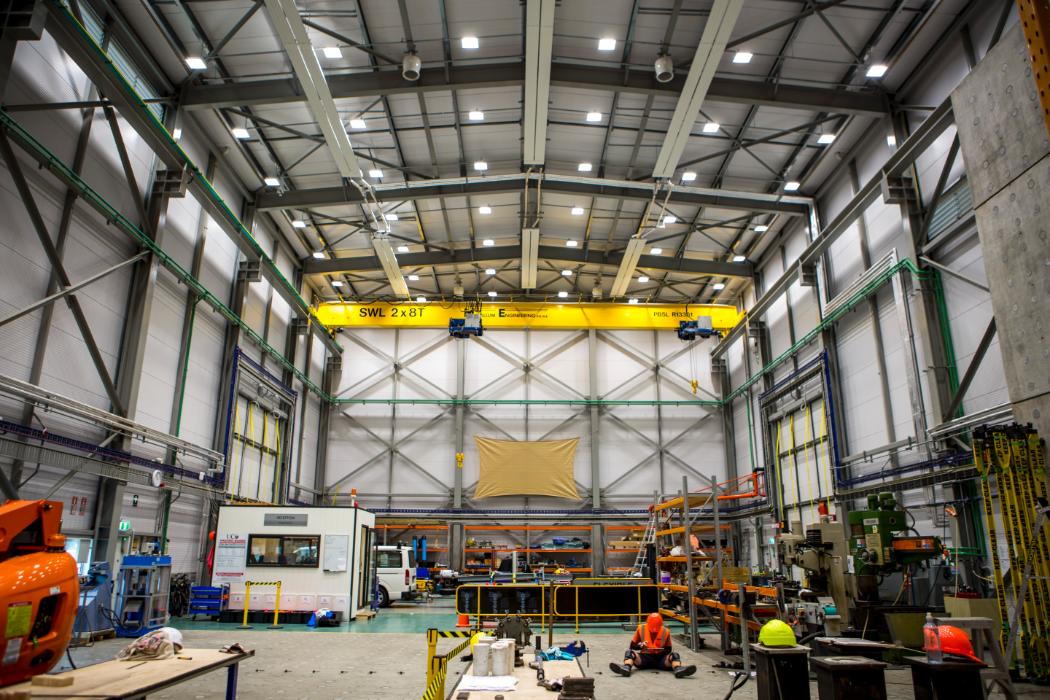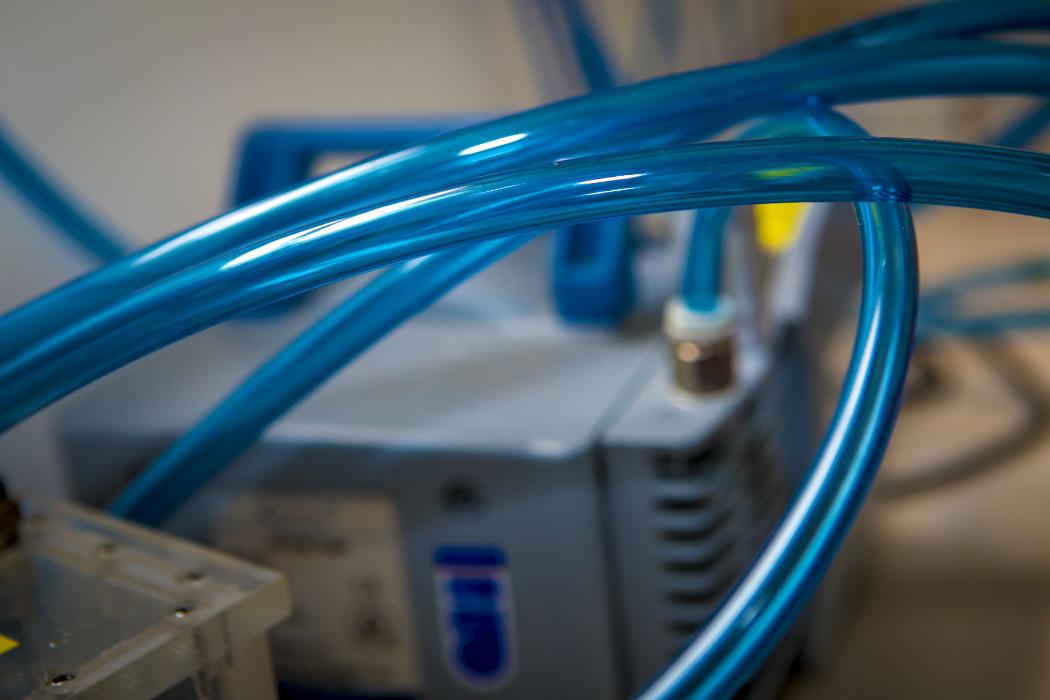Specialised services within the department include electronics technicians, a graphic designer and computer support.



Civil and natural resources engineering facilities
All our graduate students have office space in the department and there's a dedicated postgraduate computer suite. We have over 20 highly skilled, experienced technicians available to help with experimental research. Learn more about civil and natural resources engineering facilities.

Our Structural Engineering research laboratories are the largest and best-equipped in New Zealand. The labs permit a large range of static and dynamic testing.
Besides research, the main structural engineering laboratory is used for demonstrating behaviour of various structural systems to undergraduate students complementing the knowledge they gather in class.
The main laboratory comprises two large prestressed concrete strong floors (104m2 and 28.7m2) for structural testing. It is serviced by a 7.5-ton overhead crane. Equipment includes:
- 10 MN Dartec Universal Testing Machine
- Hydraulic actuators with capacity up to ±2000 kN, and strokes of ±200 mm
- 1000 kN Avery Universal Testing
- 100 kN Avery Universal Testing Machine
- 2500 kN Avery Block Testing Machine
- Uniaxial 8m2 shaking table with maximum displacement ±150 mm, maximum velocity ±100 cm/sec, maximum acceleration ±1 g, and loading mass 200 kN.
The laboratory is well equipped with movable reaction frames and measuring devices which include load cells, accelerometers, LVDTs and potentiometers. A number of digital controllers and data acquisition units are also available.
The extension wing is specifically for large-scale testing. It has a 97.5 m2 strong floor and is serviced by a 7.5-ton overhead crane. The laboratory can accommodate two-story specimens with a maximum floor area of 50 m2.
The concrete material laboratory is a specialised extension of the structural laboratory for research on cementitious construction material. The laboratory is currently being enlarged and updated.
Take a virtual tour
Fluid mechanics

The department has a dedicated fluid mechanics laboratory that supports its undergraduate teaching, postgraduate and staff research. The research facilities range from traditional large-scale flumes for open channel flow simulations, through to smaller scale tanks and flumes used for environmental fluid mechanics research.
Much of the work currently undertaken in the laboratory uses advanced optical techniques for quantitative measurement of flow properties.
These methods, which include laser induced fluorescence (LIF) and particle tracking velocimetry (PTV), require blackout conditions and specialised light sources.
Examples of some of the larger pieces of experimental apparatus include:
- The 12m long and 560mm wide main flume, used for undergraduate teaching and postgraduate research, connects to a 10m constant head recirculating system. The flume was originally built for an experimental study of open channel turbulent dispersion.
- A new 15m long, 250mm wide and 500mm deep Perspex flume used for environmental fluid mechanics research. Currently a study into the structure of free surface gravity currents is happening in the flume.\
- A 6m long, 1.5m wide and 1m deep, towing tank. A computer-controlled trolley can tow a model ocean outfall through the still surrounding fluid, simulating the behaviour of a real ocean outfall in a moving environment. Currently the tank is being used in a study of the effect of mussel farms on tidal flows.
- A 5m long, 250mm wide and 400mm deep tilting flume has been used in a number of experimental studies exploring the behaviour of intrusive gravity currents.
Geomechanics
Geomechanics facilities have laboratory, field and software resources including:
- Two advanced triaxial apparatuses, one for static stress-path testing and one for dynamic testing
- Conventional soil testing facilities including shearbox, oedometer and triaxial cells
- Truck-mounted CPT rig
- Advanced numerical modelling capabilities include original software for seismic effective stress analysis of pile foundations
- Commercially available packages PLAXIS for 2D and 3D finite-element modelling, FLAC3D for 3D finite-difference modelling and PFC3D for 3D discrete element modelling
Pavement and traffic engineering
Transportation Laboratory Equipment:
- Bitumen viscosity, aging and penetration test equipment
- British Pendulum Skid Resistance tester
- Polished Stone Tester (accelerated weathering of sealing chips)
- Gyratory and Marshall compaction of asphaltic concrete specimens
- Indirect Tensile Modulus and creep testing of asphaltic concrete specimens
- Vibratory compaction of unbound granular material specimens
- Repeated Load Triaxial Testing of unbound granular specimens
- Loadman Portable Falling Weight Deflectometer device
- Real-time traffic monitoring suite
- MetroCount traffic counting and speed measuring equipment
- Autoscope vehicle image processing camera
- Handheld laser speed gun
- TIRTL infrared traffic logger
- Psion handheld data collection devices
- Various other traffic measurement equipment (tubes, lasers)
Transportation Computer Software available:
- PLUTO - analysis of transport policy options
- TransCAD - GIS modelling of transport networks
- SATURN - mesoscopic simulation and assignment of traffic in road networks
- Paramics - microscopic simulation and visualisation of individual vehicles in road networks undertaking traffic surveys
- SIDRA - analysis of intersection performance (priority/roundabout/signalised)
- CAS - NZ Transport Agency crash database analysis and reporting
- TRARR - rural road traffic simulation
- TRIPS, TRACKS, QRS - macroscopic transport network planning
- IHSDM - safety modelling of highway geometric designs
- EEM - NZ Transport Agency project economic evaluation
- ABAQUS - finite element modelling of pavements
- CIRCLY - elastic analysis of pavement layers
- 12D - geometric road design and layout
Captif testing facility (in conjunction with the New Zealand Transport Agency).
Some equipment is available for hire. Please contact our lab manager below.
Fire engineering
Fire Engineering has a small-scale fire laboratory and a medium-scale fire laboratory. The small-scale fire laboratory contains the Cone Calorimeter used for ignition, burning rate and flame spread measurements, the wind tunnel, a small-scale furnace and the ISO ignition apparatus. The medium-scale fire laboratory contains the furniture calorimeter that can measure fires up to around 2 MW. Space is also available in the Civil and Natural Resources Engineering laboratories for specific projects.
The fire laboratories include instrumentation and data acquisition equipment used as needed for particular research and testing projects. Both the furniture and cone calorimeters are used for graduate laboratory classes as well as Masters and PhD research projects.
Research students also have access to a hot-disk apparatus to obtain solid material properties and DSC/TGA testing equipment for gas phase measurements.
The cone calorimeter is used intensively to obtain ignition and burning rate data. Materials tested have included upholstered furniture foam and fabric combinations, various species of timber, manufactured wood products, gypsum wallboard, cables and metro train construction materials.
The cone calorimeter was adapted to measure opposed flow flame spread by the apparatus referred to as the Reduced Scale Ignition and Flame spread Technique (RIFT). The RIFT is used to examine opposed flow flame spread over several species of New Zealand timber and timber products such as Beech, Rimu, Radiata Pine, Macrocarpra, Plywood, Particle board, Medium Density Fibreboard (MDF) and Laminated Veneer Lumber (LVL).
The Lateral Ignition and Flame Transport (LIFT) test apparatus is a standard test method for obtaining ignition and flame spread properties. The LIFT test apparatus was built in-house and can be set up so that materials can be tested either in the vertical or horizontal orientation. Recent work has compared the results obtained from the RIFT and LIFT.
Students taking the Fire Safety Systems course, as well as Master's research students carrying out project work, use the wind-tunnel. It was used to determine appropriate distributions of the Response Time Index (RTI) for a range of commercially available sprinklers. Measurement of the sprinkler conduction (C) factor has also been undertaken.
The small-scale furnace is used for testing structural timber connections under fire conditions. Internal connections using high strength steel bars epoxy grouted into LVL members have been under development at the university and were assessed in the furnace.
Atrium smoke control
An atrium 1/10 th scale-model was built to study the effects of spill plumes. The model consisted of a supporting steel frame with ceramic fibre insulation boards attached. The model simulated a fire within a communicating space in an atrium building, and consisted of two main units, the fire compartment and the smoke exhaust hood. Experiments investigated the entrainment of air into the spill plume in which a downstand and a balcony were present.
Water mist systems
A compartment and plenum space was designed to carry out experiments on the use of a water mist system with a displacement ventilation system. Fire tests were conducted to measure the effects of the water mist system on the compartment conditions.
ISO 5657 Ignition apparatus
The ISO 5657 ignition apparatus was used to obtain ignition and burning rate data on upholstered furniture foam and fabric combinations and various species of timber.
Furniture Calorimeter
The furniture calorimeter can be used to measure the rate of heat release of a variety of items such as furniture, piled stock or vegetation.
Students have access to a wide range of general computer applications and specialised fire modelling tools including:
- The SAFIR thermal and structural analysis program
- The Fire Dynamics Simulator (FDS) large eddy simulation CFD program
- Compartment zone modelling software such as CFAST, FPETool and BRANZFIRE
- The Simulex evacuation model
- @Risk Monte Carlo Simulation Package
- FDS modelling of the McLeans Island Road experiments
- Evacuation analysis using Simulex
The density difference between salt water and fresh water can be used to represent the flow of hot smoke in a compartment. Fire staff have been working with our colleagues in fluids to examine flows prior to backdrafts and fluids through ceiling vents. The fluids laboratory has extensive darkroom facilities and in-house expertise to support Particle Image Velocimetry (PIV) and Particle Tracking Velocimety (PTV) measuring techniques.
Environmental engineering
Our well-equipped modern laboratory occupies a floor area of 235 m2 and contains all the basic environmental chemistry analytical facilities, plus two temperature-controlled rooms and a number of laboratory-scale wastewater treatment reactors.
Major equipment includes:
- Total organic carbon analyser, with autosampler
- Ion analyser, with heater block and autosampler
- Gas chromatograph, with autosampler
- Respirometric BOD apparatus
- COD reactor (semi-micro)
- Dissolved oxygen meters
- Jar test apparatus
- Stainless steel reactor vessels (7 with capacity of 30l each)
For more information see the Civil and Natural Resources Engineering facilities page.
Hydrological and Ecological Engineering Group (HydroEco) facilities
The Hydrological and Ecological Engineering Group (HydroEco) use the Environmental laboratory and Fluids laboratory for a variety of research projects. HydroCo also have a comprehensive selection of analytical equipment used for field research investigations including:
- Inductively coupled plasma - mass spectrometry (ICP-MS) instrument
- GIS modelling laboratory
For more information see the Hydrological and Ecological Engineering facilities page.